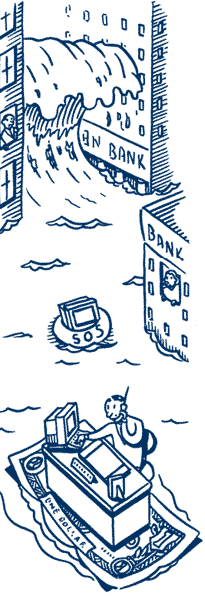Money Meltdown
Could hackers or hurricanes destroy Wall Street? Not if we all believe they can't.

Let's talk about disaster. Not the "Dow Jones Industrials dropping 200 points" kind of disaster, but the "Flood hits Wall Street" or "Salomon Brothers goes belly up" kind of disaster.
The fact that most money and surrogates for money exist today only as ones and zeros on softly humming mainframes makes it seem as if this "nonpaper economy" is increasingly vulnerable to these kinds of problems. There's something reassuring, after all, about the idea that somewhere the actual cash you own or the stock certificates you hold exist and can't be wiped away with a single keystroke. On the other hand, bills and certificates can burn or soak in a way that bits of data do not.
Of course, even if the dollars and the mutual funds are no longer tangible, the computers that store them are, which means that earthquakes, tornadoes, and electrical outages still have the potential to seriously mess up the economy. A recent IBM study suggested that the average company takes between three and five days to recover from the impact of a natural disaster and that a typical retail brokerage house loses $6.5 million every hour its systems are down. And in a fine example of "it'll only happen to the other guy" thinking, the vast majority of brokerage houses do not have formal plans or sufficient insurance to deal with the aftermath of a natural disaster.
IBM did not carry out this study, you'll be shocked to hear, simply because it was disinterestedly curious about corporate preparedness for chaos. Rather, IBM is a major player in the "disaster recovery" business. Its Business Recovery Services teams are the equivalent of the Harvey Keitel character in PulpFiction: When disaster strikes, you call the 800 number and they arrive on site to solve your problems. The market for this kind of insurance is still small, presumably because it requires you to take seriously the prospect of having your business leveled. But "disaster recovery" encompasses a mind-numbing array of software products designed to help companies put all the bits back where they belong after being flooded, shorted, or hacked. These products carry names like Replica, ARCServe, and SnapBack. Essentially, they do one of two things: They provide either a way to back up data rapidly or a way to get systems back up and running without losing data in the process. Reading the press releases for these products is eerily comforting. Nothing, you come to feel, ever really disappears.
In part, that's because nothing in this new economy is ever in just one place. Schwab, for instance, has its main server in San Francisco but regularly backs up its data on a computer in New York. Citicorp has computers in both New York and South Dakota. Many brokerages and banks have backup servers located abroad. This constant flow of data raises interesting questions (that I can't answer) about the vulnerability of these systems to hackers. But it also means that when you hear that the Fidelity Investments building has been swallowed by an earthquake in Boston, you probably don't need to worry that your mutual funds have disappeared with it.
I ndeed, one of the striking things about the nonpaper economy has been its ability to avoid real cataclysm, though there have been close calls. (Click for some of the scarier near-meltdowns.) It's probably true that corporations would hush up any real brushes with disaster, but the evidence so far suggests that the transformation of money into digitized information has not made that money noticeably less secure.

But it has contributed to the dramatic increase in trading in nearly all markets. Since the early 1970s, trading volume on U.S. stock exchanges alone has risen more than 1,000 percent; and if you toss futures, bonds, commodities, and foreign currency and equities into the mix, the increase is even more staggering. This has made financial institutions less fiscally stable as they look more to trading than to fees for profit. This matters because the institutions that run mutual funds, manage people's money, or process trades are--to state the obvious--corporations, which is to say they need to make a profit to stay in business. The recent advent of discount brokers, and particularly of online brokers, has made brokerage houses seem nothing more than glorified collections of secretaries carrying out orders--and in one sense, that's all they are. In another sense, though, these houses are really banks, holding both cash and securities. Merrill Lynch, for instance, now manages more than $70 billion in assets. If it were to fail--as corporations fail every day--what happens to those assets?
The answer is not that the assets simply disappear. The vast majority is in the form of securities that are registered--somewhere--to the individuals who own them. When a brokerage house fails, all its accounts are frozen, but eventually they get moved to another broker. And while brokers are not insured by the FDIC, there is an equivalent entity, called the Securities Investor Protection Corp., set up by federal law in 1970 but funded by the industry itself. The SIPC insures cash deposits up to $100,000 and securities up to $500,000. In addition, most large houses take out additional insurance. Vanguard has $120 million in insurance for its money-market funds, while Fidelity has $100 million for the same.
The SIPC has $1 billion in reserves, and so far it has presided over the liquidation of hundreds of brokerage houses without needing to call on the government. Again, that's because unlike with a failed savings-and-loan, a broker's failure doesn't eradicate clients' assets. Much of what the SIPC does, then, is pay for the actual process of liquidation, reassignment, and reimbursement of cash.
The interesting question, though, is what would happen if more than one large house failed at the same time--a contingency the SIPC is not equipped to deal with. In the heart of a bull market, this seems improbable. But the SIPC was created after two years on Wall Street during which 13 brokerage firms had been liquidated, leaving 40,000 customers unable to access either their cash or their stocks, and two of the largest firms came perilously close to collapsing. More recently, the collapse of Drexel Burnham Lambert and Adler, Coleman suggests that failure remains a possibility even for large houses.
Were one house to crash, we might very well see a kind of bank run, with people anxious to convert their securities into cash lest they be stuck, which in turn would exacerbate the problem across the board. Of course, at that point the government would undoubtedly step in, just as it did during the plunge of the Mexican peso, and serve as a lender of last resort. Capitalism, after all, is no fun when real failure becomes a possibility.
The SIPC, then, is more of a useful fiction than anything else, a way of reassuring investors that all the angles are covered, as in fact they are, even if not by the SIPC itself. And in that sense it is emblematic of the nonpaper economy as a whole, where everything seems vaguely uncertain and tenuous and where a crucial task is making people believe that everything will be all right. The disaster will be recovered from. The data will be backed up. And your stocks will rise. Really.